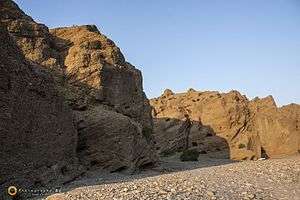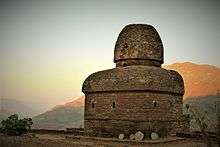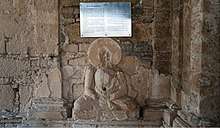Buddhism in Pakistan
Buddhism in Pakistan took root some 2,300 years ago under the Mauryan king Ashoka.[1] Buddhism has played a major role in the history of Pakistan — the land of which over time has been part of predominantly Buddhist empires such as the Indo-Greek Kingdom, the Kushan Empire, the Maurya Empire of Ashoka, the Pala Empire.


In 2012, the National Database and Registration Authority (NADRA) indicated that the contemporary Buddhist population of Pakistan was minuscule with 1,492 adult holders of national identity cards (CNICs). The total population of Buddhists is therefore unlikely to be more than a few thousand.[2] In 2017, number of Buddhist voters was stated to be 1,884 and they are mostly concentrated in Sindh and Punjab.[3]
The only functional Buddhist temple in Pakistan is in the Diplomatic Enclave at Islamabad, used by Buddhist diplomats from countries like Sri Lanka.[4]
Buddhism in antiquity
Regions
Gilgit Baltistan
.jpg)

Buddhism came to this part of the country in the late 7th century when most of the masses were practicing Bon religion. Before the arrival of Islam, Tibetan Buddhism and Bön (to a lesser extent) were the main religions in Baltistan. Buddhism can be traced back to before the formation of the Tibetan Empire. The region has a number of surviving Buddhist archaeological sites. These include the Manthal Buddha Rock, a rock relief of the Buddha at the edge of the village (near Skardu) and the Sacred Rock of Hunza. Nearby are former sites of Buddhist shelters.
Baltistan had Buddhist majority till the 15th century, before the arrival of Islam in this region. Since then most of the people converted to Islam, the presence of Buddhism in this region has now been limited to archeological sites, as the remaining Buddhists of this region moved east to Ladakh where Buddhism is the majority religion.
Gandhara
The majority of people in Gandhara, present-day Southern Khyber Pakhtunkhwa province, were Buddhist. Gandhara was largely Mahayana Buddhist, but also a stronghold of Vajrayana Buddhism. The Swat Valley, known in antiquity as Uddiyana, was a kingdom tributary to Gandhara. There are many archaeological sites from the Buddhist era in Swat. Buddhist scholar Kumāralabdha of the Taxila was comparable to Aryadeva, Aśvaghoṣa and Nagarjuna.
Uddiyana
The Buddhist sage Padmasambhava is said to have been born in a village near the present day town of Chakdara in Lower Dir District, which was then a part of Oddiyana. Padmasambhava is known as Guru Rinpoche in Tibetan and it is he who introduced Vajrayana Buddhism in Tibet.
Punjab region
Buddhism was practiced in the Punjab region, with many Buddhist monastery and stupa sites in the Taxila World Heritage Site locale. It was also practiced in the Sindh regions.
Sindh
Buddhist sites in Sindh are numerous but ill preserved and various stages of deterioration. Sites at Brahmanabad (Mansura Sanghar district, Buddhist stupa at mohen jo daro, Sirah-ji-takri near Rohri, Sukkur, Kahu Jo Daro at Mirpur Khas, Nawabshah, Sudheran jo Thul near Hyderabad, Thul Mir Rukan stupa, Thul Hairo Khan Stupa and Bhaleel Shah Thul square stupas (5th-7th century A.D) at Dadu, Kot Bambhan Thul buddhist tower near Tando Muhammad Khan. Many terracota tiles from Kaho jo Daro and Buddha statues are exhibited in Chatrapati Shivaji museum, Mumbai.[5]
Balochistan
Chinese Buddhist traveller Hiuen Tsang reported many Buddhist temples in coastal regions of Makran, Balochistan. The remains of Buddhist cave city called Godrani Caves can still be seen today.
Demographics
The presence of Pakistani Buddhists in modern pakistan is unclear,[6] although a few Pakistanis have reported themselves as Buddhist. A report mentions that they are only found in the Azad Kashmir region.[7] The Nurbakhshi sect is said to retain some elements of Buddhism.[8]
According to the National Database and Registration Authority (NADRA) in 2012 there 1,492 buddhists in holding national identity cards (CNICs).[2] In 2017 it increased to 1,884 holders. They are mostly concentrated in Sindh and Punjab.[3] According to a report most of the Baori Buddhists doesn't have CNIC cards and the actual Buddhist population could exceed 16,000.[9]
In Punjab, Buddhists live primarily in the outskirts of Mandi Yazman and Rahimyar Khan of Rohi region. Today they have around 15 colonies in various villages of Mandi Yazman.[9]
Buddhism in modern Pakistan
Tridev Roy, the Chakma chief, supported Pakistan during the 1971 Bangladesh Liberation War left the Chittagong region and settled in Pakistan. He claimed to represent the Buddhists of Pakistan by founding and chairing the "Pakistan Buddhist Society" from 1996 until his death in 2012.[10] His family stayed behind in Bangladesh.
Lala Rajoo Raam is the representative of the Baori Buddhists community. He is also a councillor for Chak number 75 DB, Union Council number 88. He also twice contested elections for the Punjab assembly.[9]
Islam and Hinduism
Gandhara remained a largely Buddhist land until around 10th century CE, when Sultan Mahmud conquered the region and introduced Islam. There was settlement of Muslims and the emigration of Buddhists.[11]

Buddhism was practiced by the majority of the population of Sindh up to the Arab conquest by the Umayyad Caliphate in 710 CE. These regions became predominantly Muslim during the rule of Delhi Sultanate and later the Mughal Empire due to the missionary Sufi saints whose dargahs (shrines) dot the landscape of Pakistan and the rest of South Asia.
Taliban destruction of Buddhist relics

The Swat Valley in Pakistan has many Buddhist carvings and stupas, and Jehanabad contains a Seated Buddha statue.[12] Kushan era Buddhist stupas and statues in Swat valley were demolished by the foreign funded Taliban and after two attempts by the foreign funded Taliban, the Jehanabad Buddha's face was dynamited.[13][14][15] Only the Bamiyan Buddhas were larger than the carved giant Buddha statue in Swat near Mangalore which the Taliban attacked.[16] The government did nothing to safeguard the statue after the initial attempt at destroying it, which did not cause permanent harm, but when the second attack took place on the statue the feet, shoulders, and face were demolished.[17] Islamists such as the Taliban and looters destroyed much of Pakistan's Buddhist artifacts left over from the Buddhist Gandhara civilization, especially in Swat Valley.[18] The Taliban deliberately targeted Gandhara Buddhist relics for destruction.[19] The Christian Archbishop of Lahore Lawrence John Saldanha wrote a letter to Pakistan's government denouncing the Taliban activities in Swat Valley including their destruction of Buddha statues and their attacks on Christians, Sikhs, and Hindus.[20] Gandhara Buddhist artifacts were also looted by smugglers.[21] A group of Italians helped repair the Buddha at Jahan Abad, Swat.[22]
Pakistan Buddhist tourism
In March 2013, a group of around 20 Buddhist monks from South Korea made the journey to the monastery of Takht-e-Bahi, 170 kilometres (106 miles) from Islamabad. The monks defied appeals from Seoul to abandon their trip for safety reasons and were guarded by Pakistani security forces on their visit to the monastery, built of ochre-coloured stone and nestled on a mountainside. From around 1,000 years BC until the seventh century AD, northern Pakistan and parts of modern Afghanistan formed the Gandhara kingdom, where Greek and Buddhist customs mixed to create what became the Mahayana strand of the religion. The monk Marananta set out from what is now northwest Pakistan to cross China and spread Buddhism on the Korean peninsula during the fourth century. The authorities are even planning package tours for visitors from China, Japan, Singapore and South Korea, including trips to the Buddhist sites at Takht-e-Bahi, Swat, Peshawar and Taxila, near Islamabad.[23]
Takht-i-Bahi
Takht means “throne” and bahi, “water” or “spring” in Persian/Urdu. The monastic complex was called Takht-i-Bahi because it was built atop a hill and also adjacent to a stream. Located 80 kilometers from Peshawar and 16 kilometers Northwest of the city of Mardan, Takht-I-Bahi was unearthed in early 20th century and in 1980 it was included in the UNESCO World Heritage list as the largest Buddhist remains in Gandhara, along with the Sahr-i-Bahlol urban remains that date back to the same period, located about a kilometer south.[24]
Taxila
The modern town of Taxila is 35 km from Islamabad. Most of the archaeological sites of Taxila (600 BC to 500 AD) are located around Taxila Museum. For over one thousand years, Taxila remained famous as a centre of learning Gandhara art of sculpture, architecture, education and Buddhism in the days of Buddhist glory.[25] There are over 50 archaeological sites scattered in a radius of 30 km around Taxila. Some of the most important sites are: Dhamarajika Stupa and Monastery (300 BC - 200 AD), Bhir Mound (600-200 BC), Sirkap (200 BC - 600 AD), Jandial Temple (c.250 BC) and Jaulian Monastery (200 - 600 AD).[26]
A museum comprising various sections with rich archaeological finds of Taxila, arranged in chronological order and properly labeled, has been established close to the site.[26]
Mingora
Mingora, 3 km away from Saidu Sharif, has yielded magnificent pieces of Buddhist sculpture and the ruins of a great stupa. Shingardar Stupa is one of the famous located near Bariko Other stupas like Amaan Kot and Jehan-a-Abad are too a great asset.[27]
Swat
The Lush-green valley of Swat District—with its rushing torrents, icy-cold lakes, fruit-laden orchards and flower-decked slopes—is ideal for holiday-makers intent on relaxation. It also has a rich historical past: "Udayana" (the "Garden") of the ancient Hindu epics; "the land of enthralling beauty", where Alexander of Macedonia fought and won some of his major battles before crossing over to the plains of Pakistan, and "the valley of the hanging chains" described by the famous Chinese pilgrim-chroniclers, Faxian and Xuanzang in the fifth and seventh centuries. Swat was once a cradle for major strands of Buddhism, where 1,400 monasteries flourished: Little Vehicle, Great Vehicle and the Esoteric sects. It was the home of the famous Gandhara School of Sculpture which was an expression of Graeco-Roman form in the local Buddhist tradition.[28]
However, the ruins of great Buddhist stupas, monasteries and statues are found all over Swat.[29][30]
Buddhist scholars from Pakistan
list of Buddhist scholars who hailed from present day regions of Pakistan
- Asanga from Peshawar, 4th century C.E.
- Vasubandhu from Peshawar, 4th to 5th century CE
- Lokaksema from Gandhara, 147 CE
- Dharmarakṣa (265–313)
- Prajñā (c. 810)
- Maranatha c. 384 (introduced Buddhism in Korea)
- Tridev Roy, Pakistani Buddhist politician and leader
See also
- History of Buddhism
- Buddhism in Afghanistan
- History of Pakistan
- Index:Buddhism by country
References
- "Buddhism In Pakistan". pakteahouse.net. Archived from the original on 20 January 2015. Retrieved 20 January 2015.
- "Over 35,000 Buddhists, Baha'is call Pakistan home". Tribune. Archived from the original on 2 November 2012.
- https://www.hindustantimes.com/world-news/pakistan-elections-non-muslim-voters-up-by-30-hindus-biggest-minority/story-gRmBeL4TaBBgY6ZTURRA7M.html
- "Vesak Festival in Islamabad". mfa.gov.lk. Archived from the original on 13 November 2016. Retrieved 5 May 2018.
- "Ancient Buddhist terracottas from Mirpurkhas in Pakistan". Art of South Asia, the Silk Road and Beyond. 18 October 2016. Retrieved 8 August 2018.
- Thread, Not Scissor Common Spiritual Heritage For Peace And Harmony, Ahmad Salim, SARRC – December 2008
- 800 years of Buddhism in Pakistan, Emi Foulk, The Friday Times, July 18, 2008
- "THE NURBAKHSHI RELIGION IN BALTISTAN, Xabier Rentería, 26-11/2007". Archived from the original on 3 June 2019. Retrieved 15 October 2018.
- https://www.thefridaytimes.com/meeting-pakistans-buddhists/
- Monks to start peace march tomorrow,August 05, 2002
- Ousel, M. (1997). Ancient india and indian civilization. Routledge.
- Hays, Jeffrey. "EARLY HISTORY OF BUDDHISM - Facts and Details". factsanddetails.com. Archived from the original on 19 October 2017. Retrieved 5 May 2018.
- Malala Yousafzai (8 October 2013). I Am Malala: The Girl Who Stood Up for Education and Was Shot by the Taliban. Little, Brown. pp. 123–124. ISBN 978-0-316-32241-6.
The Taliban destroyed the Buddhist statues and stupas where we played Kushan kings haram Jehanabad Buddha.
- Wijewardena, W.A. (17 February 2014). "'I am Malala': But then, we all are Malalas, aren't we?". Daily FT. Archived from the original on 24 September 2015.
- Wijewardena, W.A (17 February 2014). "'I am Malala': But Then, We All Are Malalas, Aren't We?". Colombo Telegraph. Archived from the original on 25 September 2015.
- "Attack on giant Pakistan Buddha". BBC NEWS. 12 September 2007. Archived from the original on 19 April 2016.
- "Another attack on the giant Buddha of Swat". AsiaNews.it. 10 November 2007. Archived from the original on 25 September 2015.
- "Taliban and traffickers destroying Pakistan's Buddhist heritage". AsiaNews.it. 22 October 2012. Archived from the original on 12 May 2016.
- "Taliban trying to destroy Buddhist art from the Gandhara period". AsiaNews.it. 27 November 2009. Archived from the original on 23 September 2015.
- Felix, Qaiser (21 April 2009). "Archbishop of Lahore: Sharia in the Swat Valley is contrary to Pakistan's founding principles". AsiaNews.it. Archived from the original on 23 September 2015.
- Rizvi, Jaffer (6 July 2012). "Pakistan police foil huge artefact smuggling attempt". BBC News. Archived from the original on 24 September 2015.
- Khaliq, Fazal (7 November 2016). "Iconic Buddha in Swat valley restored after nine years when Taliban defaced it". DAWN. Archived from the original on 7 January 2017.
- "Pakistan hopes for Buddhist tourism boost". Dawn News. Archived from the original on 20 January 2015.
- "Takht Bhai". www.findpk.com. Archived from the original on 10 August 2015.
- "Taxila". www.pakistantoursguide.com/. Archived from the original on 21 January 2015.
- "Buddhism in Taxila". www.findpk.com/Pakistan/html/buddhist_sites.html. Archived from the original on 10 August 2015.
- "Buddhism in Mingora". www.cybercity-online.net/. Archived from the original on 26 November 2014.
- "Buddhism in SWAT". www.cybercity-online.net. Archived from the original on 26 November 2014.
- "Taliban defeated by the quiet strength of Pakistan's Buddha". The Nation. 12 July 2018. Retrieved 23 April 2020.
- "Buddhism in SWAT". www.asia-planet.net/pakistan/region-cities.htm. Archived from the original on 23 September 2015. Retrieved 21 January 2015.
External links
| Wikimedia Commons has media related to Buddhism in Pakistan. |

